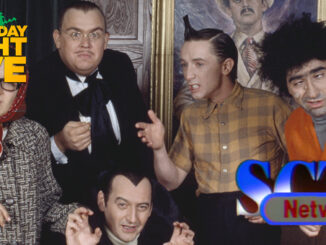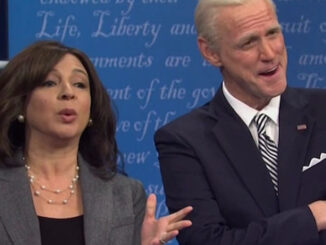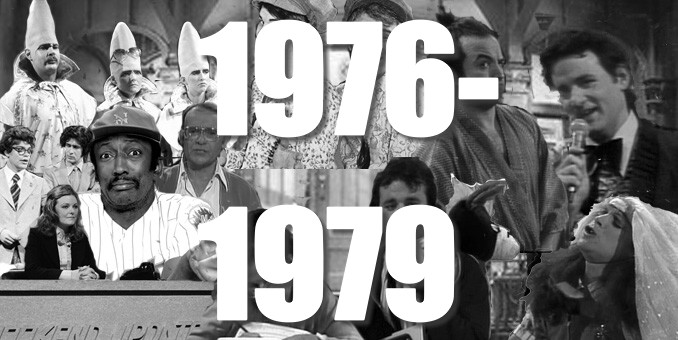
In honor of Saturday Night Live‘s 50th Anniversary, we will be going through its rich and varied history and breaking down its legendary run into easy to digest eras. Some eras might last for years, others only one season. But each era is one that either marked a change in the show, were driven by a remarkable personality of a star, or marked a special part of the history of the program. Today, we find the show at a crossroads after losing their biggest star, Chevy Chase.
Chevy Chase was the breakout star of Saturday Night Live. That might be hard to reconcile for younger generations who only know him as the cranky old man who got fired from Community, but it’s the truth.
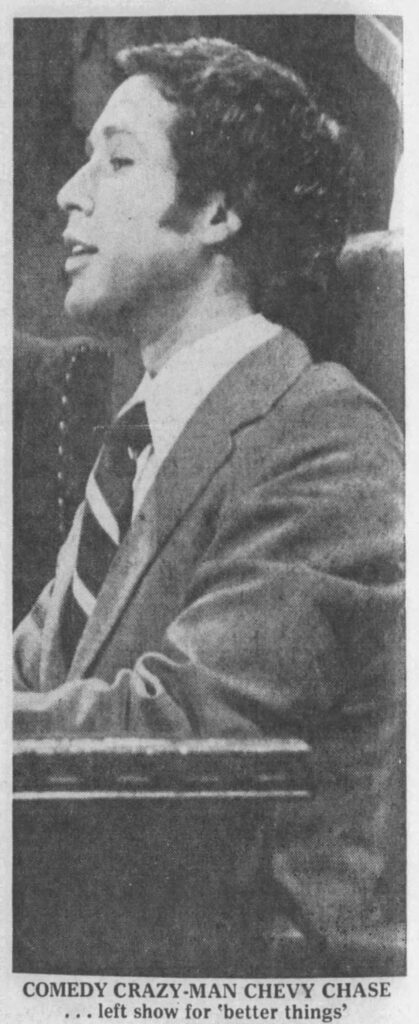
Leading up to the 1976 general election, Parade Magazine polled 1000 college students at 20 colleges and asked them which non-politician they wanted to see as President of the United States. Chevy Chase was one of the eight people the students chose. A group of women called Man Watchers Inc. release their list of the Ten Most Watchable Males of 1976. Chase also made that list too. (O.J. Simpson was also one of the ten, meaning Chase wasn’t the biggest fall from grace of the ten.) “He’s merry, witty and brilliant,” Man Watchers president Suzy Mallery explained. “We like his impish, devilish smile on his very expressive face. A joy to watch.”
Chase was getting meetings with Warner Brothers, United Artists and Paramount to star in films. He was chosen to perform at the Presidential Inaugural. He had hired Barbara Streisand’s manager to help out in Hollywood. He was listed as the star of the film Tunnel Vison, a movie he made before SNL made him famous and in which he has less than five minutes of screen time, in the film’s newspaper ads. Everyone wanted to be in the Chevy Chase business because the Chevy Chase business was booming.
In retrospect, it seems obvious at the time that Chevy Chase wouldn’t be long for SNL. After all, how do you keep the boy on the farm after they have been getting career advice from Warren Beatty? But when Chase returned for the second season of the show, it gave fans hope. Chase returned for the first few episodes of the new season, although, he phoned it in for a couple of them. (No, literally. He injured himself in a pratfall and only appeared on the show via a telephone call from the hospital.) But during that time, articles started appearing listing his contract troubles with NBC and a lengthy interview with the Associated Press’ Bob Thomas where Chase bemoaned about how tired he was and how he never had any time for outside projects. The press blitz told a pretty solid story that Chase will inevitably be leaving SNL.
The inevitable came after the October 30, 1976 show, the last episode to feature Chase as a cast member. He would appear in pre-taped filmed pieces a couple times in the following weeks, but his time on SNL was done. “Officially, Chevy is off the show forever,” Lorne Michaels told reporters at Chase’s farewell party. “But this is his family and everyone visits his family.”
Michaels would come to regret that statement.
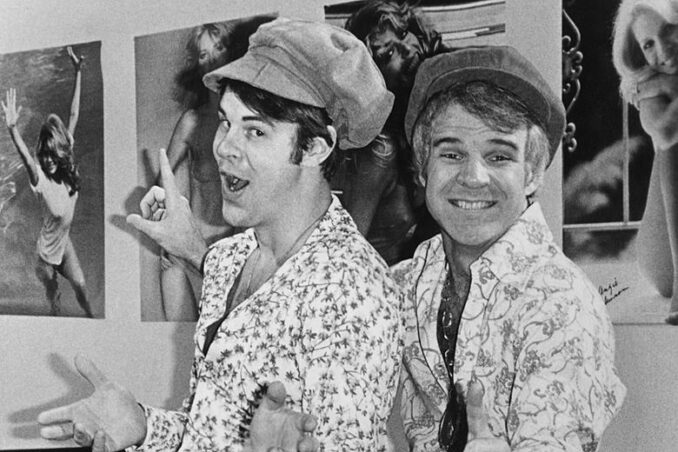
Chevy Chase was gone from Saturday Night Live. His negotiations with NBC garnered him three prime-time specials, of which it seems like only two aired–The Chevy Chase Show on May 5, 1977 and Chevy Chase’s National Humor Test on May 10, 1979. Neither interfered with Chase’s burgeoning film career.
The press reacted to Chase’s departure just as you’d expect them to–with gloom and doom. Tom Shales wrote a national syndicated article, intended as a form of promotion for the forthcoming SNL cast album, that came off as if he was writing the show’s obituary. The Akron Beacon Journal, in advertising Shales’ article, editorialized that the show was “pretending it’s still a hit comedy.” Don Stanley of the Vancouver Sun was more direct with his criticism: “Saturday Night needs Chevy Chase. Jane Curtin tried the news report, but he’s Chevy Chase and she’s not. Dan Aykroyd is a master at 24 and all that, but, unlike Chase, he’s not effortlessly funny. John Belushi is too aggressive.”
It appeared that, by this reaction, the show wouldn’t last past the end of the season. And here we are, 49 years later, still talking about it. Why? Because – HOT TAKE – Chevy Chase leaving was the best thing to happen to SNL.
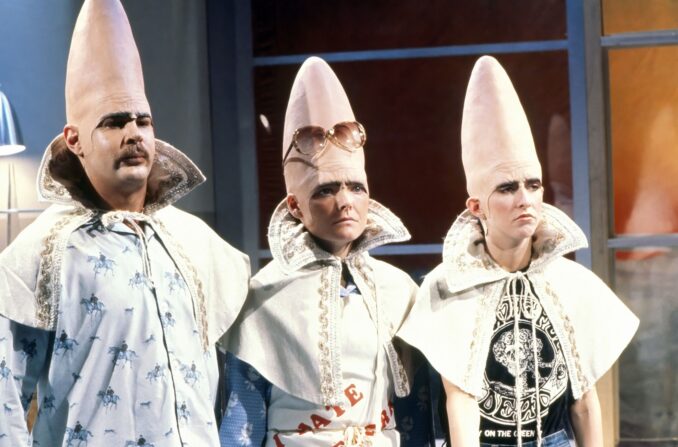
If Chase had stayed on SNL, it would have become the Chevy Chase Show. The mix of Chase’s popularity, his massive ego and a network that was in his corner would have pushed the rest of the cast into the background. Or worse, Chase would be resentful of anytime another cast member got the chance to shine. In Bob Woodward’s book, Wired, he details how Chase, jealous of John Belushi being the focus of “The Last Voyage of the Starship Enterprise” sketch tried to upstage him during dress rehearsal. He was reined in for the show, but if you ever wondered why Chase’s Leonard Nimoy was especially histrionic in the sketch, there’s your answer.
But with Chase gone, the rest of the cast got to stretch their comedy muscles and shine. Just take a look at these famous sketches and characters that first arrived in the post-Chase era:
- Irwin Mainway
- The “Right To Extreme Stupidity Sketch”
- Coneheads
- “Ask President Carter”
- E. Buzz Miller and Christie Christina
- Leonard Pinth-Garnell
- Nick The Lounge Singer
- The Festrunk Brothers
- The Franken and Davis Show
- Judy Miller
- Roseanne Roseannadanna
- “Little Chocolate Donuts”
- Olympia Cafe (Cheeseburger, Cheeseburger)
- The Nerds (Lisa Loopner)
- Don’t Look Back in Anger
- Point/Counterpoint (“Jane, you ignorant slut”)
- La Dolce Gilda
- The Blues Brothers
- Theodoric of York, Medieval Barber
- “King Tut”
- Father Guido Sarducci
- Uncle Roy
- Chico Escuela
- The Julia Child Sketch
- Candy Slice
- The Widettes
 And this era was greatly helped by Chase’s direct “replacement”: Bill Murray. Your opinions might differ, but I find Murray far funnier than Chase. Chaser’s humor is more erudite and snide. Murray’s is more jovial and relaxed. To use the “would you have a beer with them” canard, I’d pick Murray any day. Chase seems the type of who would sip his chardonnay and just insult you all night. Murray seems like the guy who would turn the night into a grand party, and be your hype man for the whole night,
And this era was greatly helped by Chase’s direct “replacement”: Bill Murray. Your opinions might differ, but I find Murray far funnier than Chase. Chaser’s humor is more erudite and snide. Murray’s is more jovial and relaxed. To use the “would you have a beer with them” canard, I’d pick Murray any day. Chase seems the type of who would sip his chardonnay and just insult you all night. Murray seems like the guy who would turn the night into a grand party, and be your hype man for the whole night,
Chase’s decision to leave seemed like a good idea at the time. He started his film career with a number of absolute classics: Foul Play, Caddyshack, National Lampoon’s Vacation, Fletch and Three Amigos. But the classics started to dwindle and were replaced by flops and stinkers. Unfortunately, while the quality of his output started to decline, the largeness of his ego only got bigger. His final major role on Community ended due to his legendary abrasive behavior backstage.
Which brings us to his SNL hosting duties. Chase came back to host the show eight times, but his hosting stints are most remembered for two negative experiences. First was his first time back, for the February 18, 1978 episode. This is the episode where he got in a fist fight with Murray backstage. But that wasn’t the end of his bad behavior. He forced Jane Curtin out of the Weekend Update spot so he could take it over like some kind of returning conquering hero.
Then there was his November 16, 1985 hosting gig. Chevy was in rare form this week. In the 2014 book Live From New York: The Complete, Uncensored History of Saturday Night Live as Told by Its Stars, Writers, and Guests, openly gay cast member Terry Sweeney said that Chase came up to him and said, “I’ve got an idea for a sketch for you. How about we say you have AIDS, and we weigh you every week?” During the same week, he also made a point of insulting Robert Downey, Jr. as well: “Didn’t your father used to be a successful director? Whatever happened to him? Boy, he sure died, you know, he sure went to hell.”
Chase has not been back to host SNL since 1997, leading many to say he has been banned from ever hosting the show again. What these people fail to realize was that was the last time Chevy Chase ever did anything worthy of being allowed to host the show.
While this era was what could be called SNL’s “Glory Days,” it would soon be faced with a pair of departures that would set the show at the crossroads and change its fortunes forever. We’ll cover that next time.



